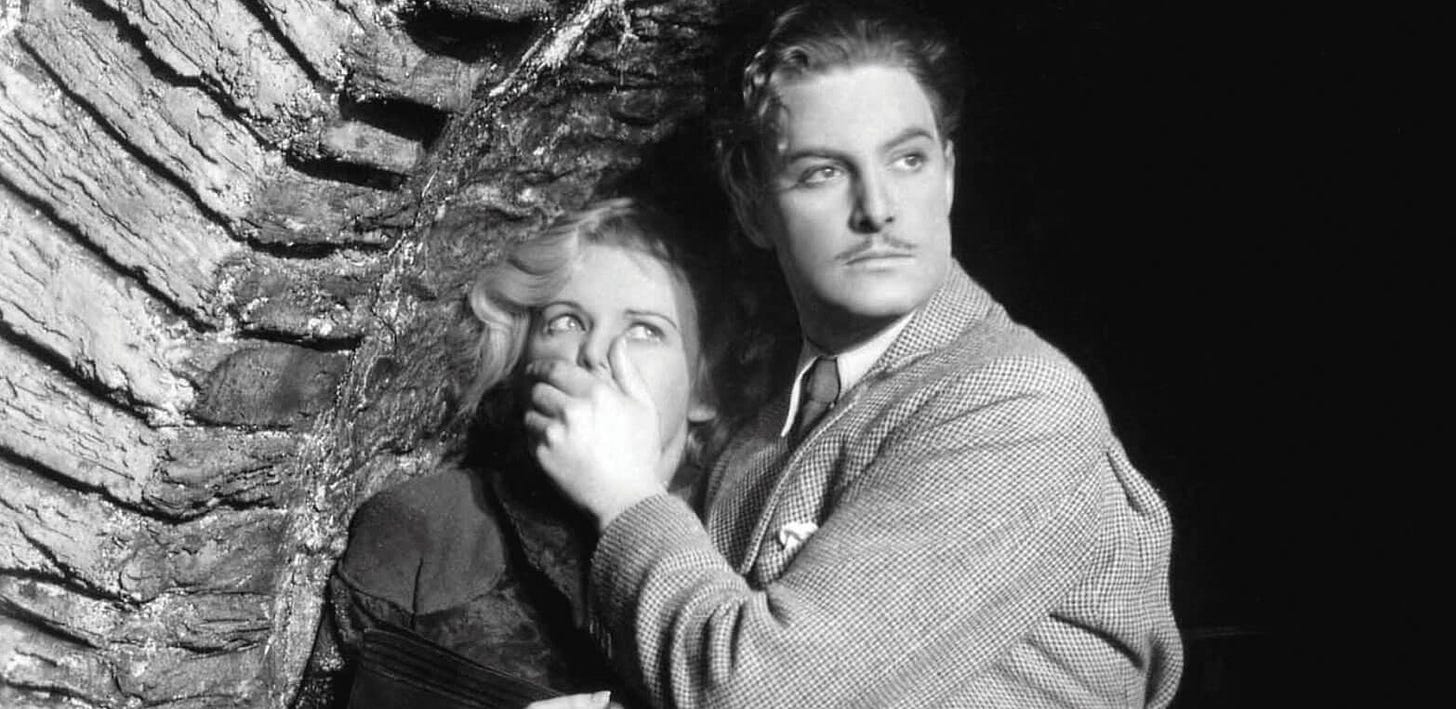The many, many Thirty-Nine Steps
The Thirty-Nine Steps is a genre-defining adventure thriller by John Buchan. Published in 1915, it is the 'man on the run' classic that keeps on giving, generation after generation.
John Buchan’s 1915 novel began something that we got to enjoy ever since in countless iterations - the story of the innocent protagonist who is forced to go on the run, escape his pursuers time and time again and finally, against all odds, wins the day. In 1935, Alfred Hitchcock gave us the novel’s first - and I think best - of many adaptations to come.
Hitchcock’s movie gave the already successful novel another major push - and it has reverberated ever since - here just a films of that sub-genre that may seem familiar: North by Northwest; Three Days of the Condor; The Marathon Man; The Fugitive; Enemy of the State; Salt; the Bourne films; the Mission Impossible franchise and many, many more. See what I mean? They all have the innocent/framed protagonist who, while on the run, quick of feet and mind, intrepidly and ingeniously fights the odds to win the day. And that was exactly what Buchan gave us with his original yarn.
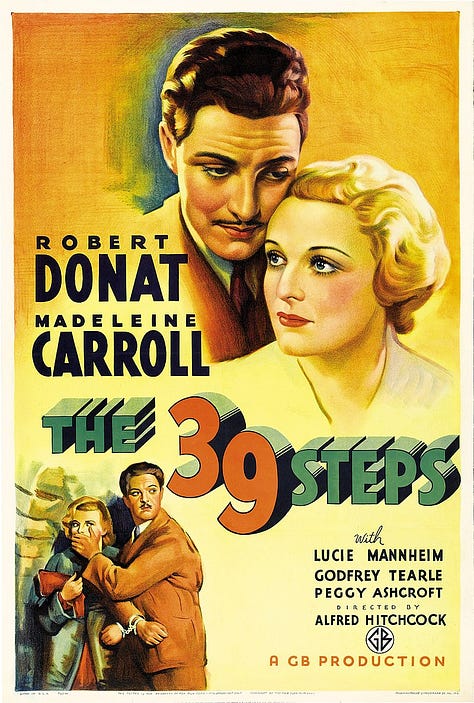

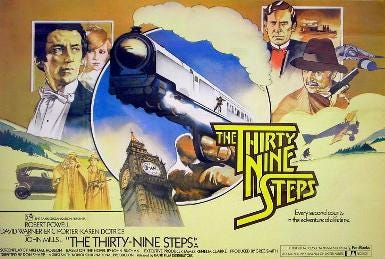
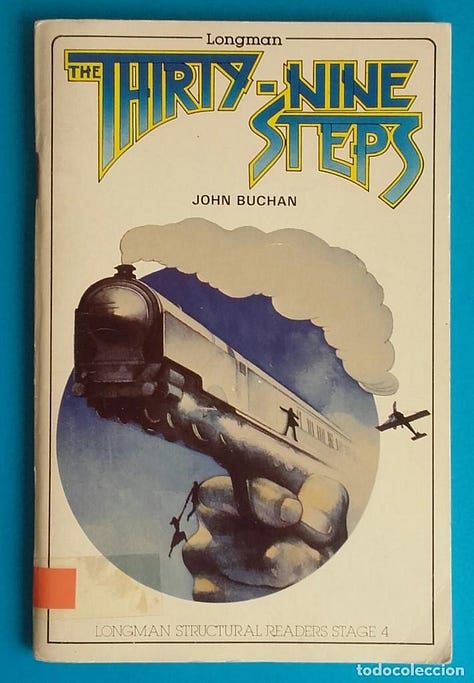
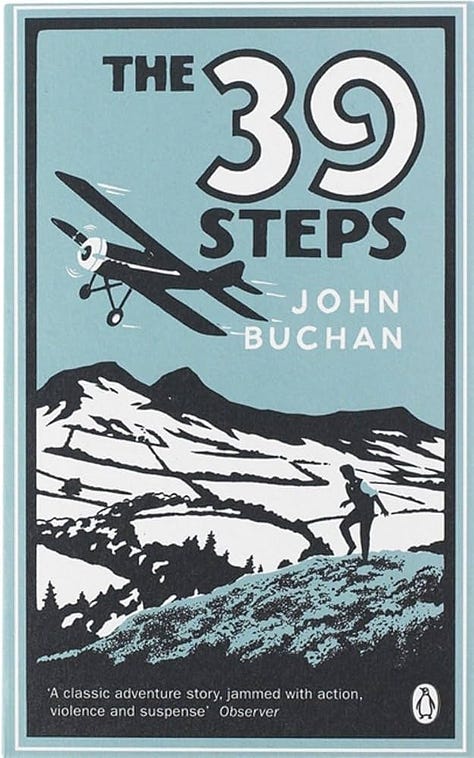
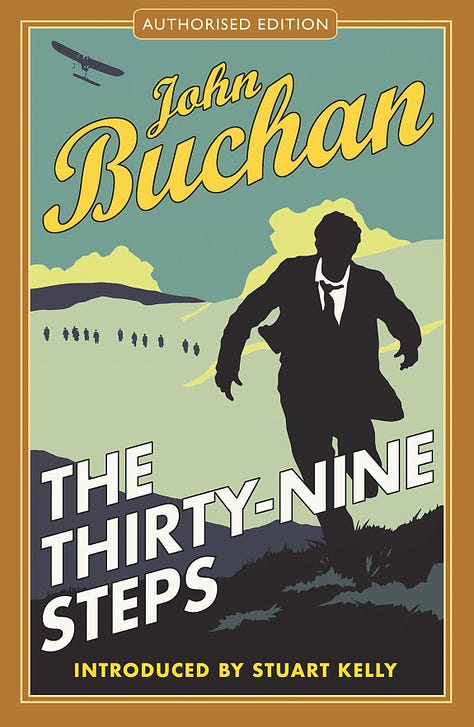
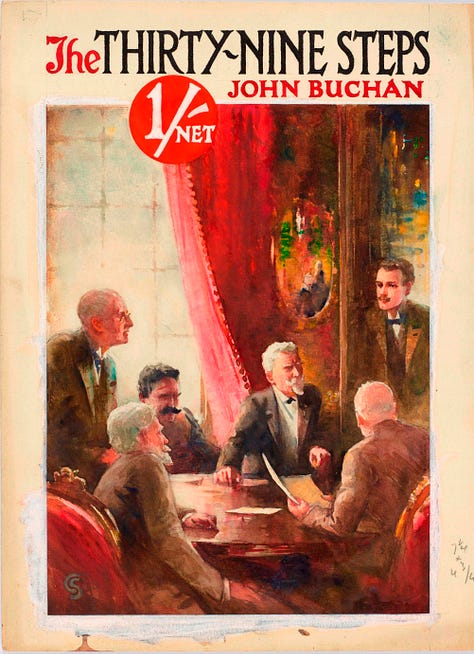
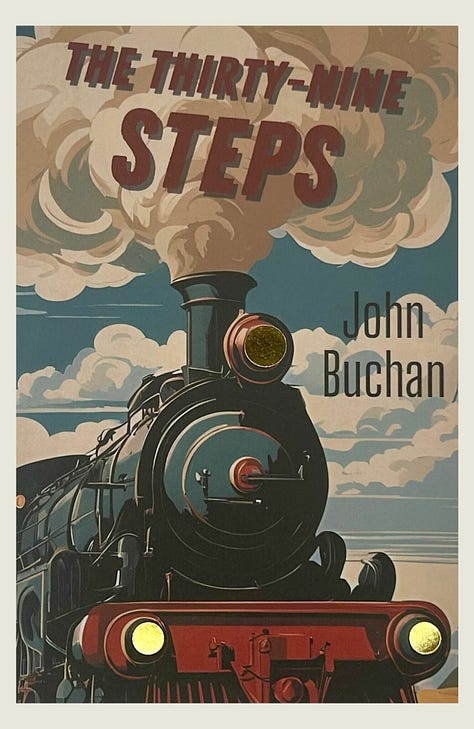
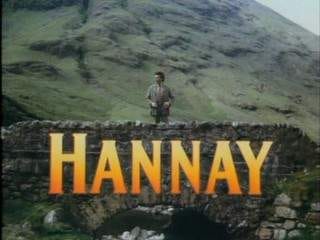
As a screenwriter, I’ve had the good fortune to be hired to adapt four novels (two of those screenplays were produced and two, alas, never made it that far). I had not thought of doing adaptations, thought I’d hate doing them - but quite the opposite was true. I’ve very much enjoyed the process. And so today, when I watch films based on novels I’ve read, I can’t help watching them with the eyes of both audience and screenwriter.
After reading the original The Thirty-Nine Steps as a teen, I’ve just recently listened to the audiobook version voiced by none other than Robert Powell (who played the lead in the 1978 film adaptation - more on him and that version below). It put me in the mood to rewatch the old films - here they are, with my thoughts on the choices filmmakers made on their adaptations:
The 39 Steps (1935)
Hitchcock decided to use the numeric 39 for the title. His The 39 Steps, starring Robert Donat and Madeleine Carroll, is very, very different from the novel - and yet, most later versions took their cue from Hitchcock’s version and not from the original novel. Hitchock and his writers built a romance into the film (women barely feature in the novel), and did so with great success. It doesn’t slow the story at all, but instead infuses it with an additional layer that comes with charm, wit and character development. The choice to use a vaudeville performer with an incredible memory as key to solving the mystery is also the film’s invention.
There are many more differences. Some of them large - such as the story having nothing to do with ships, but instead the design for a silent aircraft engine that the German spies wanted smugggle out of England. A small, but wonderful change is also that the main antagonist doesn’t have an oddly birdlike way of drooping his eyes (as in the novel), but instead he misses a bit of his left hand’s pinkie, Clearly, something that’s far more visual and Hitchcock, when it comes to the visual, has always excelled.
Importantly, there’s also the Thirty-Nine Steps themselves. Hitchcock’s version turned that into the name of a secret organization, whereas in the novel there are actual, physical thirty-nine steps that form a key to the mystery’s solution. The organization in the novel is called The Black Stone. Another thing that Hitchcock also solves handily is a glaring coincidence.
When you write thrillers, you get to give yourself one coincidence, one. Everything else must be the consequence of something that has happened in the story - at least that’s the way I’ve always handled it. Usually that coincidence comes at the start, with the protagonist being in the wrong place at the wrong time. But Buchan has his Richard Hannay run away to Scotland (because he’s originally from there and knows his way around) … and then in all of Scotland he just so happens to stumble into the very house of the antagonist. In Hitchcock’s film, the dying spy at the beginning hands Hannay a map of Scotland with a circled location. Bam, now it all makes sense.
Watch Hitchcock’s film here in full:
The 39 Steps (1959)
Now we have The 39 Steps in color - and the version directed by Ralph Thomas is certainly colorful, with Kenneth More playing his Richard Hannay with the special More charm. The whole film feels lighter, there’s no sense of thriller, no sense of real danger - it’s more of a jolly romp. The 1959 version focused intensely on Hitchcock’s adaptation (with the novel, once again, taking a distant backseat). Hitchcock’s inventions of a female co-lead, of a daring bridge escape, the music hall with that ‘Mr. Memory’, the missing finger tip, the 39 Steps as a secret organization, are all here in this version. And sometimes the dialogue is identical, too.
There are differences, of course. For one, they had the necessary funds to shoot on location. The film looks very, very pretty. While Hitchcock’s version is mostly studio, and giving us an oppressive black and white and gloomy Scotland, the 1959 version feels like a tourist campaign, beautiful vistas, rides with cars and bicycles, lots of heather, lovely all around. Both the director and the writer undoubtedly tried to make the case for the remake - it couldn’t be identical - it had to have something to make it stand on its own two feet - beyond nice scenery, what could that be?
Well, director Ralph Thomas said that he wanted to stay close to the original, but to make the film its own thing by a) putting the setting into the 1950s and b) by producing “the film with the feel of a comedy”. I think he achieved this quite nicely. Kenneth More fits the film like a glove; the whole bicycle excursion is humorous, so is the entire section with the occultist inn-keeper, the lecture he has to invent on the spot for a hall filled with school girls, etc. And finally, while this remake of Hitchcock’s original really was entirely unnecessary, Kenneth More’s charm still makes it an enjoyable time.
Watch the Kenneth More starrer in full:
The Thirty Nine Steps (1978)
Someone at Rank, the same studio behind the first two films, probably thought that all good things come in threes - and so, in 1978, the third The Thirty Nine Steps was released. This one actually brought the tale back into the time of the novel, the time before the first World War. It looks and feels like a tale set in the world of Sherlock Holmes - a look and feel about as different from the previous version as could be. Before this version’s Richard Hannay, portrayed by Robert Powell, even puts in an appearance, more than ten minutes pass with threats of pre-war spy danger, with people being assassinated, and with Scudder - the spy catalyst that upends Hannay’s life - taking the lead.
Once Hannay comes into the picture, this film takes on a different kind of intensity based on the strength of Robert Powell’s craft. The filmmakers claimed that this film was an important new adaptation of the novel. They considered the first two films old-fashioned and said that modern audiences wanted something that was fast-paced and with acting suited to the times. Well, I guess they were right, as the film proved to be one of “the “most popular movies of 1979 at the British box office.”
Now, since the film is, at least in part, more interested in the original novel, where the spies were intent on uncovering the secrets of the British fleet, it severely goes off the rails towards the end when the big secret turns out to be a bomb in Westminster Palace, intended to cause a terrorist incident that creates the unrest needed to start the Great War. This end leads - one cannot help but think of Harold Lloyd - to a scene with our protagonist hanging from the hands of the Big Ben clock in order to stop the bomb. Ludicrous as this sounds, it is well paced and thrilling - something that, in our times, you could definitely imagine Ethan Hunt do in order to stop a bomb. A most unlikely stunt, definitely Mission Impossible material.
The success of the film led to Robert Powell starring in the spin-off TV series Hannay - a show Richard Hannay’s exploits before The Thirty-Nine Steps. They’ve made thirteen episodes and I have to admit that I haven’t seen any of them … but now that I’m deep in Hannay world, I definitely want to watch some of them!
Watch the 1978 film in full:
The 39 Steps (2008)
Now, don’t think there were no adaptations between the previous film and this 2008 version commissioned by the BBC - more on that later. But as for this one, 2008’s The 39 Steps, it is a let-down from start to finish in terms of plot, acting and staging. I’ve read that it was produced by BBC Scotland’s drama unit - and clearly they wanted to put the most Scotland into this tale. Well, they do go all out with the ending showing an enemy submarine popping out of a loch … Oh, and the love interest, played by Lydia Leonard, turns out to be a British secret agent. I guess they were trying to add a twist there, it absolutely doesn’t work.
The choices and contrivances in this film are unfortunate at best. One example: Our hero, on the run through Scottish moorland, tumbles down a hill onto a road where he’s nearly run over by a car that just so happens to contain his future love interest (and secret agent as we’ll find out eventually). It also so happens that this woman’s brother (driving the car) is a local party candidate. They immediately think him to be the speaker for a local party gatherings - which is organized by the woman’s uncle, who will turn out to be one of the bad guys. He speaks at the gathering, then the chase continues and the woman decides to rush off with him.
Squabbles ensue, as they climb walls and steal cars and are caught by the bad guys - because she is a suffragette and he is very much against the suffragette movement. Yes, seriously. It feels like an utterly irrelevant bit inserted for what was surely thought modern audiences would appreciate - the idea of a strong woman. In this film, with this story, it makes no sense at all.
Rupert Penry-Jones delivers none of what any of the previous Hannay-actors brought to the role. And there’s terrifically bad dialogue and zero chemistry between him and his female co-star. Whatever the director and the actor were going for, they failed. The whole film, from start to finish, feels dull, feels like amateur theater.
If you must, here’s that film in full:
I’ve mentioned that there were many more adaptation of the famous novels. There is a play - and there are a whopping fourteen radio adaptations, among them many versions there was one with David Niven as Richard Hannay, another production from 1938 gives us the tale by none other than Orson Welles. Take the time to follow the link, because it begins with an introduction of Welles about the author of the novel who, at that time, was the Governor General of Canada (he had been appointed by King George in 1935).
At this point it well worth mentioning that diving into John Buchan’s life might be well worth your time. What a life. It would be quite enough for a person to have penned over one hundred books - but he was also a lawyer, a journalist, a private secretary, Director of Information during WWI and later Head of Intelligence. There’s more - and all of it eventually led to that appointment in Canada (where he died in 1940). To give you one odd look at the man - here he is, in 1937, wearing a native tribe’s headdress:
On this curious and, to me, unsettling image, I’ll end this post.
Wishing you lovely day.
Cheers,
PS: Ready for your next 39 Steps adaptation? It’ll come to Netflix soon, a mini-series starring Benedict Cumberbatch. Apparently it’ll be a contemporary retelling of the story. Well, color me intrigued. Can definitely see Cumberbatch as Richard Hannay.




